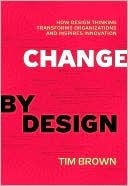More on this book
Community
Kindle Notes & Highlights
by
Tim Brown
Read between
December 21, 2017 - March 10, 2018
Design thinking begins with skills designers have learned over many decades in their quest to match human needs with available technical resources within the practical constraints of business.
Design thinking relies on our ability to be intuitive, to recognize patterns, to construct ideas that have emotional meaning as well as functionality, to express ourselves in media other than words or symbols.
Linear thinking is about sequences; mind maps are about connections. This visual representation helps me see the relationships between the different topics I want to talk about, it gives me a more intuitive sense of the whole, and it helps me to think about how best to illustrate an idea.
We can think of them as inspiration, the problem or opportunity that motivates the search for solutions; ideation, the process of generating, developing, and testing ideas; and implementation, the path that leads from the project room to the market.
design thinking is fundamentally an exploratory process; done right, it will invariably make unexpected discoveries along the way, and it would be foolish not to find out where they lead.
A nimble team of design thinkers will have been prototyping from day one and self-correcting along the way. As we say at IDEO, “Fail early to succeed sooner.”
The willing and even enthusiastic acceptance of competing constraints is the foundation of design thinking. The first stage of the design process is often about discovering which constraints are important and establishing a framework for evaluating them. Constraints can best be visualized in terms of three overlapping criteria for successful ideas: feasibility (what is functionally possible within the foreseeable future); viability (what is likely to become part of a sustainable business model); and desirability (what makes sense to people and for people).
design thinker will bring them into a harmonious balance.
They do so because they have shifted their thinking from problem to project.
The project is the vehicle that carries an idea from concept to reality.
A culture that believes that it is better to ask forgiveness afterward rather than permission before, that rewards people for success but gives them permission to fail, has removed one of the main obstacles to the formation of new ideas.
“converting need into demand.”
Their actual behaviors, however, can provide us with invaluable clues about their range of unmet needs.
The evolution from design to design thinking is the story of the evolution from the creation of products to the analysis of the relationship between people and products, and from there to the relationship between people and people.
The mission of design thinking is to translate observations into insights and insights into products and services that will improve lives.
We build these bridges of insight through empathy, the effort to see the world through the eyes of others, understand the world through their experiences, and feel the world through their emotions.
“unfocus group,”
They are open to new possibilities, alert to new directions, and always willing to propose new solutions.
At IDEO we have dedicated rooms for our brainstorming sessions, and the rules are literally written on the walls: Defer judgment.
David Kelley calls prototyping “thinking with your hands,” and he contrasts it with specification-led, planning-driven abstract thinking.
There are many approaches to prototyping, but they share a single, paradoxical feature: They slow us down to speed us up. By taking the time to prototype our ideas, we avoid costly mistakes such as becoming too complex too early and sticking with a weak idea for too long.
“See-Plan-Act-Refine-Communicate”
The best and most successful experience brands have a number of things in common that may provide us with some secure guidelines. First, a successful experience requires active consumer participation. Second, a customer experience that feels authentic, genuine, and compelling is likely to be delivered by employees operating within an experience culture themselves. Third, every touchpoint must be executed with thoughtfulness and precision—experiences should be designed and engineered with the same attention to detail as a German car or a Swiss watch.
“the paradox of choice.”
We are at a critical point where rapid change is forcing us to look not just to new ways of solving problems but to new problems to solve.
In the world of business, every idea—however noble—must survive the test of the bottom line.
people’s expectations are evolving.
consumers shift from the expectation of functional performance to a more broadly satisfying experience.
products become more like services, services are becoming more like experiences.
Design is about delivering a satisfying experience. Design thinking is about creating a multipolar experience in which everyone has the opportunity to participate in the conversation.


